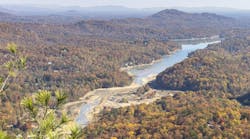
Those of us concerned with surface water quality generally keep a wary eye on the amount of nutrients entering our lakes and rivers. Nitrogen and phosphorus from fertilizers—much of it from agricultural lands, some from urban stormwater runoff—are a big contributor to algae blooms and dead zones, and in high concentrations in the drinking water supply, nutrients can pose dangers to human health as well.
We give a great deal of thought to where the fertilizer ends up, but somewhat less to where it comes from. Some of it, such as phosphate fertilizer that’s been essential to corn and soybean farming in the US, comes from mines, and these in themselves are controversial because of the waste products they generate.
Recently in Mulberry, FL, a fertilizer company experienced what its chief executive termed “a very unfortunate event” when a sinkhole opened up beneath a pile of that waste, dumping millions of gallons of acidic water into an aquifer that serves as a drinking water supply. The aquifer also received “unknown quantities of phosphogypsum, a mildly radioactive fertilizer byproduct,” as this article reports. The company is now working to repair the sinkhole by patching it with concrete, pumping the contaminated water out of the aquifer, and paying to monitor potentially affected drinking water wells through 2018, all of which will cost about $60 million, with another $40 million due to the state if it fails to follow through. So far, water samples from wells in the area have shown no contamination.
Although this was an unexpected incident—and really bad luck about the sinkhole—there are many other examples of contamination from fertilizer waste. Florida produces about 70% of the country’s phosphate rock, from which phosphate fertilizer is processed. Phosphogypsum is produced in large quantities and is stored in so-called gyp stacks. As the article notes, “Collectively, they cover thousands of acres and each can reach 500 feet high.” A spokesperson for the Sierra Club says, “Each is a disaster waiting to happen.” More than 20 years ago a sinkhole opened at this same fertilizer plant, but was quickly repaired. The company that currently owns the plant has paid to clean up hazardous waste from its plants in Florida and Louisiana, and a different Florida company went bankrupt in 2001, abandoning a plant; in that case, state officials disposed of the hazardous wastewater in the Gulf of Mexico.
Environmental groups are calling for either stricter regulations or a freeze on mining permits until a better way is found to deal with the byproducts of the mining process. Some are calling for an outright ban on fertilizer production.
Does your area have problems with nutrients and groundwater or surface water—seasonal algae blooms, or worse?
About the Author
Janice Kaspersen
Janice Kaspersen is the former editor of Erosion Control and Stormwater magazines.

